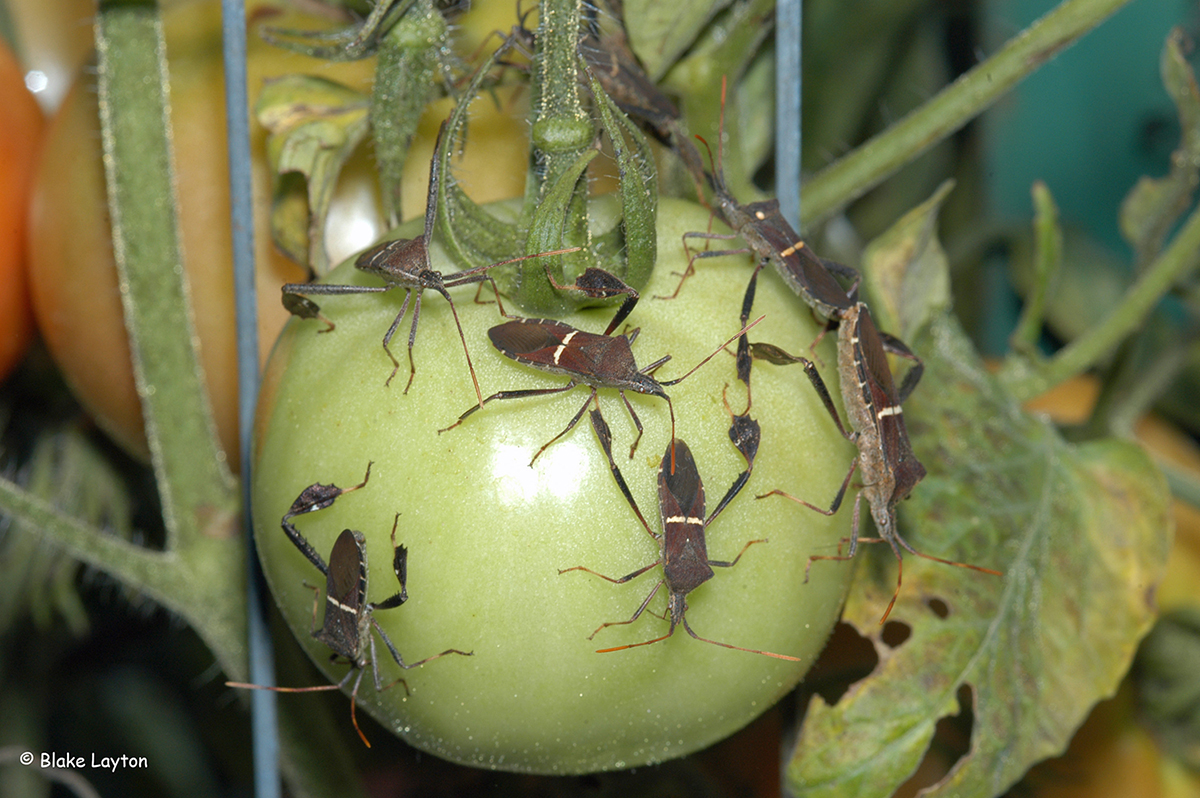Leaffooted Bugs, Vol. 4, No. 24

Leaffooted Bugs
Leptoglossus phyllopus
Order: Hemiptera
Family: Coreidae
Leaffooted bugs can ruin a late-season vegetable garden. Like stink bugs, which feed in a similar manner, leaffooted bugs attack a wide range of garden vegetables including, tomatoes, peppers, eggplant, okra, peas, and beans. They are especially damaging to tomatoes and they love tomatillios. Damage is caused primarily by the highly mobile adults, which feed on fruit with their piercing-sucking mouthparts, injecting their toxic saliva in the process and causing soft, sunken spots in the fruit. In addition, even mildly damaged fruit will often have an off taste. Also like stink bugs, leaffooted bugs have a distinctive, unpleasant odor, and they tend to congregate in groups.
Adults make a loud buzzing sound as they fly, and gardeners who are busy picking vegetables are often startled by the sound and sometimes mistake these for bees or wasps. The nymphs are reddish orange with black legs. Infestations are highest in late summer and fall because they have already completed one or more generations and especially because adults are attracted to lush, productive vegetable gardens as they are flying from nearby, and not so nearby, weeds and row crops that have matured and are no longer suitable hosts.
Control: Spraying with an effective insecticide to directly contact as many insects as possible is the key to successfully controlling leaffooted bugs. Plan on spraying every 7 to 10 days once you begin to see, or hear, or smell, significant numbers of adults in the garden. Because adults often fly out of the garden when disturbed (when they hear you coming with the sprayer) only to return later, spraying early in the morning, when temperatures are cooler and cold-blooded insects move more slowly, can help improve control. Because treatment is most often needed during the harvest period, it is important to choose insecticides with short pre-harvest intervals (PHIs) and to coordinate your spraying and picking schedule. Zeta-cypermethrin (GardenTech Sevin Insect Killer Concentrate) and permethrin (several brand names) are two effective insecticides that have short PHIs on most garden vegetables. See product labels for details.
Some gardeners use a trap crop of large-flowered sunflowers to attract leaffooted bugs away from vegetable crops they are trying to protect. It only takes a dozen or so sunflower plants to do this in an average garden. Adults are attracted to the sunflowers and will lay their eggs and produce nymphs there. But be sure to spray the bugs on the sunflowers before the nymphs can mature and move to your vegetables. Otherwise you will have a nursery crop, rather than a trap crop!
For more information see page 8, and pages 12-14 of Extension Publication 2347, Insect Pests of the Home Vegetable Garden.
Blake Layton, Extension Entomology Specialist, Mississippi State University Extension Service.
The information given here is for educational purposes only. Always read and follow current label directions. Specific commercial products are mentioned as examples only and reference to specific products or trade names is made with the understanding that no discrimination is intended to other products that may also be suitable and appropriately labeled.
